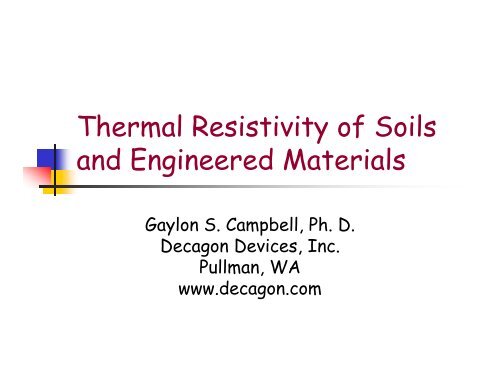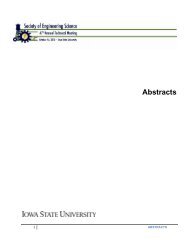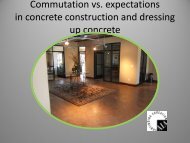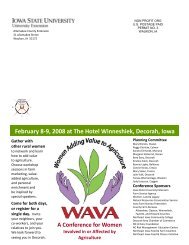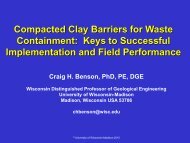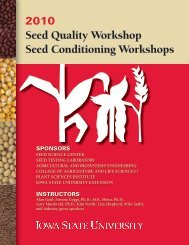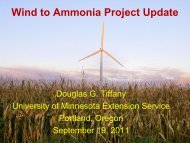Th l R i ti it f S il Thermal Resistivity of Soils and Engineered Materials
Th l R i ti it f S il Thermal Resistivity of Soils and Engineered Materials
Th l R i ti it f S il Thermal Resistivity of Soils and Engineered Materials
You also want an ePaper? Increase the reach of your titles
YUMPU automatically turns print PDFs into web optimized ePapers that Google loves.
<strong>Th</strong>ermal Resis<strong>ti</strong>v<strong>it</strong>y <strong>it</strong> <strong>of</strong> So<strong>il</strong>s<br />
<strong>and</strong> <strong>Engineered</strong> <strong>Materials</strong><br />
Gaylon S. Campbell, Ph. D.<br />
Decagon Devices, Inc.<br />
Pullman, WA<br />
www.decagon.com
Phoenix Scout Mission to Mars<br />
June 25, 2008 – Oct., 2008<br />
TECP: <strong>Th</strong>ermal <strong>and</strong><br />
electrical<br />
proper<strong>ti</strong>es p probe
TECP Purpose<br />
•Measure thermal <strong>and</strong> electrical<br />
proper<strong>ti</strong>es <strong>of</strong> Mar<strong>ti</strong>an regol<strong>it</strong>h<br />
•From those measurements, infer<br />
liquid water content, ice content, <strong>and</strong><br />
pore size distribu<strong>ti</strong>on
Some geotechnical applica<strong>ti</strong>ons<br />
<strong>of</strong> so<strong>il</strong> thermal proper<strong>ti</strong>es<br />
• Buried power transmission cables<br />
What is the thermal resistance between a buried<br />
power line <strong>and</strong> the external environment?<br />
• Ground source heat pump installa<strong>ti</strong>ons<br />
For a given volume <strong>of</strong> so<strong>il</strong>, how much heat can be<br />
stored? How fast can <strong>it</strong> be stored?<br />
• Burial <strong>of</strong> high level radio-ac<strong>ti</strong>ve ac<strong>ti</strong>ve waste<br />
How hot w<strong>il</strong>l <strong>it</strong> get? How w<strong>il</strong>l <strong>it</strong> affect moisture<br />
patterns?
<strong>Th</strong>ermal Proper<strong>ti</strong>es <strong>of</strong> So<strong>il</strong><br />
Impact Wind Power Genera<strong>ti</strong>on
U. S. Na<strong>ti</strong>onal Electrical<br />
Code: Annex B (2005)<br />
“Typical values <strong>of</strong> thermal resis<strong>ti</strong>v<strong>it</strong>y: rho”<br />
average so<strong>il</strong> (90 percent <strong>of</strong> USA) 90<br />
Concrete 55<br />
Damp so<strong>il</strong> 60<br />
very dry so<strong>il</strong> 120
Outline<br />
•Defini<strong>ti</strong>ons<br />
•<strong>Th</strong>ermal proper<strong>ti</strong>es <strong>of</strong> porous materials<br />
•Measuring so<strong>il</strong> thermal proper<strong>ti</strong>es<br />
•St<strong>and</strong>ards S d d for thermal proper<strong>ti</strong>es<br />
•Correc<strong>ti</strong>ve measures
<strong>Th</strong>e thermal proper<strong>ti</strong>es <strong>of</strong><br />
interest are<br />
•<strong>Th</strong>ermal conduc<strong>ti</strong>v<strong>it</strong>y (k )<br />
Ra<strong>ti</strong>o <strong>of</strong> heat flux dens<strong>it</strong>y to temperature<br />
gradient: 0.1 to 3 W/(m·K)<br />
•<strong>Th</strong>ermal resis<strong>ti</strong>v<strong>it</strong>y ( )<br />
R ip l f th m l nd <strong>ti</strong> <strong>it</strong> :<br />
Reciprocal <strong>of</strong> thermal conduc<strong>ti</strong>v<strong>it</strong>y :<br />
33 to 1000 cm·C/W
Which is best, conduc<strong>ti</strong>v<strong>it</strong>y<br />
or resis<strong>ti</strong>v<strong>it</strong>y?<br />
For so<strong>il</strong>, conduc<strong>ti</strong>v<strong>it</strong>y is almost always<br />
preferable to resis<strong>ti</strong>v<strong>it</strong>y:<br />
•Better sta<strong>ti</strong>s<strong>ti</strong>cal proper<strong>ti</strong>es<br />
•More correct for averaging<br />
•More linear w<strong>it</strong>h water content<br />
•A more correct percep<strong>ti</strong>on <strong>of</strong><br />
significance
More thermal proper<strong>ti</strong>es<br />
•Volumetric specific heat (C )<br />
Heat required to raise the temperature <strong>of</strong><br />
un<strong>it</strong> volume by 1 K (or C):<br />
1 to 3 MJ/(m 3 K)<br />
•<strong>Th</strong>ermal diffusiv<strong>it</strong>y (D )<br />
Ra<strong>ti</strong>o <strong>of</strong> conduc<strong>ti</strong>v<strong>it</strong>y to specific heat;<br />
Ra<strong>ti</strong>o <strong>of</strong> conduc<strong>ti</strong>v<strong>it</strong>y to specific heat;<br />
measure <strong>of</strong> propaga<strong>ti</strong>on rate <strong>of</strong> thermal<br />
disturbances: 0.1 to 0.7 mm 2 /s
Modeling So<strong>il</strong> <strong>Th</strong>ermal<br />
Proper<strong>ti</strong>es<br />
•So<strong>il</strong> is a mixture <strong>of</strong> solid, liquid<br />
(water) <strong>and</strong> gas (air <strong>and</strong> water vapor)<br />
•<strong>Th</strong>e thermal proper<strong>ti</strong>es <strong>of</strong> the so<strong>il</strong><br />
depend on the thermal proper<strong>ti</strong>es <strong>of</strong><br />
the cons<strong>ti</strong>tuents, their volume<br />
frac<strong>ti</strong>ons, <strong>and</strong> how they are mixed
So<strong>il</strong> Moisture Concepts <strong>and</strong><br />
Defini<strong>ti</strong>ons<br />
Air 25%<br />
Water 25%<br />
Solid 50%<br />
• A “saturated” so<strong>il</strong><br />
has no air<br />
• After satura<strong>ti</strong>on so<strong>il</strong>s<br />
typically quickly drain<br />
to “field capac<strong>it</strong>y”<br />
• Further drying is<br />
mainly due to plant<br />
water uptake
<strong>Th</strong>ermal proper<strong>ti</strong>es <strong>of</strong><br />
“pure” so<strong>il</strong> cons<strong>ti</strong>tuents<br />
k<br />
W/(mK)<br />
C<br />
MJ/(m 3 K)<br />
D<br />
mm 2 /s<br />
So<strong>il</strong> Minerals 2.5 2.3 1.09<br />
Gran<strong>it</strong>e 3 2.2 1.36<br />
Quartz 8.8 2.1 4.19<br />
Organic matter 0.25 2.5 0.10<br />
Water 06 0.6 418 4.18 014 0.14<br />
Ice 2.2 1.9 1.16<br />
Air 0.025025 0.001001 20.83<br />
From Campbell <strong>and</strong> Norman (1998)
Volumetric Specific Heat:<br />
varia<strong>ti</strong>on w<strong>it</strong>h water content<br />
(MJ/m3 K )<br />
Vo<br />
l. Sp. Ht.<br />
35 3.5<br />
3<br />
2.5<br />
2<br />
1.5<br />
1<br />
0.5<br />
0<br />
S<strong>and</strong><br />
Clay<br />
Organic<br />
<strong>Th</strong>e specific heat <strong>of</strong> a mixture <strong>of</strong><br />
air, water <strong>and</strong> solids is the sum <strong>of</strong><br />
each volume frac<strong>ti</strong>on, mul<strong>ti</strong>plied by<br />
<strong>it</strong>s specific heat<br />
0 0.1 0.2 0.3 0.4 0.5<br />
Volumetric Water Content
Specific Heat Take-Home<br />
• <strong>Th</strong>e volumetric specific heat <strong>of</strong> so<strong>il</strong>, rock<br />
<strong>and</strong> concrete is about 2 (±1) MJ m -3 K -1<br />
• Volumetric specific heat varies linearly<br />
w<strong>it</strong>h water content<br />
• Volumetric specific heat can <strong>of</strong>ten be<br />
computed more accurately than measured –<br />
you need volumetric water content t <strong>and</strong> bulk<br />
dens<strong>it</strong>y
Temperature dependence <strong>of</strong><br />
so<strong>il</strong> thermal conduc<strong>ti</strong>v<strong>it</strong>y<br />
<strong>Th</strong>ermal Co onduc<strong>ti</strong>v<strong>it</strong>y<br />
- W/(m K)<br />
1.8<br />
1.6<br />
1.4<br />
12 1.2<br />
1<br />
0.8<br />
06 0.6<br />
0.4<br />
0.2<br />
0<br />
50% solids<br />
0 0.1 0.2 0.3 0.4 0.5<br />
90 C<br />
65 C<br />
25 C<br />
No Vap.<br />
Water Content - m 3 /m 3
Liquid Return Flow: so<strong>il</strong> as a<br />
heat pipe<br />
1.8<br />
<strong>Th</strong>er rmal Condu uc<strong>ti</strong>v<strong>it</strong>y - W/(m K)<br />
1.6<br />
1.4<br />
1.2<br />
1<br />
08 0.8<br />
0.6<br />
0.4<br />
0.2<br />
0<br />
liq<br />
90 C<br />
vap<br />
No vapor<br />
0 0.1 0.2 0.3 0.4 0.5<br />
Water Content - m 3 /m 3
Temperature Dependence <strong>of</strong><br />
<strong>Th</strong>ermal Resis<strong>ti</strong>v<strong>it</strong>y<br />
C/W)<br />
<strong>Th</strong>ermal Res sis<strong>ti</strong>v<strong>it</strong>y (cm<br />
600<br />
500<br />
400<br />
300<br />
200<br />
100<br />
0<br />
25 C<br />
65 C<br />
0 0.2 0.4 0.6<br />
Water Content (m3/m3)<br />
U. S. Electrical Code<br />
90 C Average so<strong>il</strong> 90<br />
Concrete 55<br />
Damp so<strong>il</strong> 60<br />
Very dry so<strong>il</strong> 120
Response to <strong>Th</strong>ermal<br />
Conduc<strong>ti</strong>v<strong>it</strong>y <strong>of</strong> Solids<br />
<strong>Th</strong>er rmal Cond duc<strong>ti</strong>v<strong>it</strong>y - W/(mC)<br />
2.5<br />
2<br />
1.5<br />
1<br />
0.5<br />
0<br />
quartz s<strong>and</strong><br />
loam<br />
organic<br />
25 C<br />
0 0.1 0.2 0.3 0.4 0.5<br />
Water Content - m3/m3
Resis<strong>ti</strong>v<strong>it</strong>y response to solids<br />
proper<strong>ti</strong>es<br />
<strong>Th</strong> hermal Res sis<strong>ti</strong>v<strong>it</strong>y (c cm C/W)<br />
1000<br />
900<br />
800<br />
700<br />
600<br />
500<br />
400<br />
300<br />
200<br />
100<br />
0<br />
loam<br />
quartz<br />
organic<br />
0 0.1 0.2 0.3 0.4<br />
Water Content (m3/m3)
Response to Compac<strong>ti</strong>on<br />
2<br />
<strong>Th</strong>e ermal Condu uc<strong>ti</strong>v<strong>it</strong>y - W/( (m K)<br />
1.8<br />
1.6<br />
1.4<br />
1.2<br />
1<br />
0.8<br />
0.6<br />
04 0.4<br />
0.2<br />
0<br />
Loam so<strong>il</strong><br />
25C<br />
17% pores<br />
50% pores<br />
60% pores<br />
0 01 0.1 02 0.2 03 0.3 04 0.4 05 0.5 06 0.6<br />
Water Content - m 3 /m 3
Compac<strong>ti</strong>on effects on<br />
thermal resis<strong>ti</strong>v<strong>it</strong>y<br />
s<strong>ti</strong>v<strong>it</strong>y (cm<br />
C/W)<br />
<strong>Th</strong>e ermal Resi<br />
600<br />
400<br />
200<br />
0<br />
60% pores<br />
50% pores<br />
17% pores<br />
0 0.1 0.2 0.3 0.4 0.5<br />
3 3<br />
Water Content (m 3 /m 3 )
Take-home<br />
• <strong>Th</strong>ermal conduc<strong>ti</strong>v<strong>it</strong>y <strong>of</strong> porous material<br />
depends on:<br />
• Composi<strong>ti</strong>on<br />
• Temperature<br />
• Dens<strong>it</strong>y<br />
• Water content<br />
• <strong>Th</strong> i “ ld ” l f <strong>il</strong> th l<br />
• <strong>Th</strong>ere is no “golden” value for so<strong>il</strong> thermal<br />
conduc<strong>ti</strong>v<strong>it</strong>y – you need to measure <strong>it</strong>
How to get values for<br />
<strong>Th</strong>ermal Proper<strong>ti</strong>es<br />
•Compute them from composi<strong>ti</strong>on,<br />
dens<strong>it</strong>y, water content <strong>and</strong><br />
temperature (best for sp. Ht.)<br />
•Measure them using the line heat<br />
source (best for conduc<strong>ti</strong>v<strong>it</strong>y)
Line heat source methods<br />
for thermal proper<strong>ti</strong>es<br />
•Place a line heat source in the sample<br />
•Apply heat to the source <strong>and</strong> measure<br />
<strong>it</strong>s temperature over <strong>ti</strong>me<br />
•From the slope <strong>of</strong> temperature vs.<br />
logar<strong>it</strong>hm <strong>of</strong> <strong>ti</strong>me determine k
<strong>Th</strong>ermal conduc<strong>ti</strong>v<strong>it</strong>y: line<br />
heat source method<br />
ange (C )<br />
Tem pe<br />
ra ture C h<br />
0.6<br />
0.5<br />
0.4<br />
0.3<br />
0.2<br />
01 0.1<br />
0<br />
k = 0.5<br />
k = 1.0<br />
k = 2.0<br />
0.1 1 10 100<br />
Time (s)<br />
k propor<strong>ti</strong>onal to<br />
1/slope
Making a reading on a<br />
sample<br />
• Insert the needle<br />
• May need a p<strong>il</strong>ot hole<br />
• Turn on the controller<br />
• Press Enter<br />
• Wa<strong>it</strong> 5 – 10 minutes –<br />
controller heats needle,<br />
measures temperature,<br />
<strong>and</strong> computes k<br />
• Read the result from<br />
display
Example <strong>of</strong> k measurement<br />
Temp perature Ris se (C)<br />
0.4<br />
0.3<br />
0.2<br />
0.1<br />
0<br />
y = 0.0906x + 0.0564<br />
R 2 = 0.9998<br />
=153 C cm/W<br />
y = 0.0853x + 0.008<br />
R 2 = 0.9996<br />
=144 C cm/W<br />
0 1 2 3 4<br />
ln t or ln t/(t-t o<br />
)<br />
hea<strong>ti</strong>ng cooling hea<strong>ti</strong>ng, excluded cooling, excluded
Contact Resistance Errors<br />
•Contact resistance errors occur any<br />
<strong>ti</strong>me there is an air gap around a single<br />
needle probe<br />
•No simple correc<strong>ti</strong>on is possible<br />
•Long read <strong>ti</strong>mes minimize these errors<br />
•Worst W in dry materials<br />
•<strong>Th</strong>ermal grease some<strong>ti</strong>mes helps
St<strong>and</strong>ards for thermal<br />
conduc<strong>ti</strong>v<strong>it</strong>y or resis<strong>ti</strong>v<strong>it</strong>y<br />
• ASTM D 5334-08 (2008) St<strong>and</strong>ard test methods<br />
for determina<strong>ti</strong>on <strong>of</strong> thermal conduc<strong>ti</strong>v<strong>it</strong>y <strong>of</strong> so<strong>il</strong><br />
<strong>and</strong> s<strong>of</strong>t rock by thermal needle probe procedure.<br />
Vol. 04.08, 08 ASTM, 100 Barr-Harbor Dr., West<br />
Conshocken, PA 19428-2059.<br />
• IEEE STD 442-1981 IEEE guide for <strong>Th</strong>ermal<br />
Resis<strong>ti</strong>v<strong>it</strong>y <strong>it</strong> Measurements . <strong>Th</strong>e Ins<strong>ti</strong>tute t <strong>of</strong><br />
Electrical <strong>and</strong> Electronics Engineers, Inc. 345 East<br />
47 Street, New York, NY 10017<br />
• Bristow, K. 2002 . <strong>Th</strong>ermal Conduc<strong>ti</strong>v<strong>it</strong>y <strong>it</strong> . p1209-<br />
1226. Methods <strong>of</strong> So<strong>il</strong> Analysis. Part 4 So<strong>il</strong><br />
Science Society <strong>of</strong> America, Inc. 677 South Segoe<br />
Rd. Madison, WI 53711-1086<br />
1086.
Comparison <strong>of</strong> st<strong>and</strong>ards<br />
ASTM<br />
IEEElab<br />
SSSA<br />
Probe length NS 100 mm NS<br />
Probe diam. NS 2.4 mm “thin”<br />
Record length NS 600 s 60 s<br />
Recording Elect. h<strong>and</strong> Elect.<br />
Analysis Rgr. 2 pt. Rgr<br />
Heat/cool yes no yes
Important points<br />
• Temperature drift during measurement can<br />
cause serious errors in hea<strong>ti</strong>ng-only<br />
analyses (as specified in older st<strong>and</strong>ards)<br />
• Probes can’t be used in layered or<br />
inhomogeneous media<br />
• Probes must be in good contact w<strong>it</strong>h so<strong>il</strong> –<br />
thermal grease can some<strong>ti</strong>mes help. Long<br />
read <strong>ti</strong>mes help a lot
<strong>Th</strong>ermal dryout curves<br />
•<strong>Th</strong>e rela<strong>ti</strong>onship between thermal<br />
conduc<strong>ti</strong>v<strong>it</strong>y (or resis<strong>ti</strong>v<strong>it</strong>y) <strong>and</strong> water<br />
content for a so<strong>il</strong> or other porous<br />
material<br />
al<br />
•Water content is an important<br />
variable, but dens<strong>it</strong>y, mineralogy <strong>and</strong><br />
temperature are also important.<br />
Need to hold these constant.
Dryout Curves –<br />
Measurement <strong>and</strong> Modeling<br />
• Pack a sample<br />
• Saturate w<strong>it</strong>h water<br />
• Measure wet conduc<strong>ti</strong>v<strong>it</strong>y<br />
• Weigh sample<br />
• Oven dry<br />
• Measure dry conduc<strong>ti</strong>v<strong>it</strong>y<br />
• Compute water content<br />
t<br />
• F<strong>it</strong> the model using wet <strong>and</strong><br />
dry conduc<strong>ti</strong>vi<strong>ti</strong>es
Dryout curves on S<strong>and</strong><br />
uc<strong>ti</strong>v<strong>it</strong>y (W /mK)<br />
<strong>Th</strong>e ermal Cond<br />
2.0<br />
1.5<br />
1.0<br />
0.5<br />
0.0<br />
single sample 1<br />
single sample 2<br />
0 0.1 0.2 0.3 0.4 0.5<br />
Volumetric Water Content (m 3 /m 3 )<br />
Data from Dr. G. Todd Vanek
Dryout curves on S<strong>and</strong><br />
uc<strong>ti</strong>v<strong>it</strong>y (W /mK)<br />
<strong>Th</strong>e ermal Cond<br />
2.0<br />
1.5<br />
1.0<br />
0.5<br />
0.0<br />
single sample 1<br />
single sample 2<br />
model singlesample<br />
sample<br />
0 0.1 0.2 0.3 0.4 0.5<br />
Volumetric Water Content (m 3 /m 3 )<br />
Data from Dr. G. Todd Vanek
S<strong>and</strong> data on a resis<strong>ti</strong>v<strong>it</strong>y<br />
scale<br />
<strong>Th</strong>erm mal Resis<strong>ti</strong>v<strong>it</strong>y<br />
4<br />
3<br />
2<br />
1<br />
single sample 1<br />
single sample 2<br />
mul<strong>ti</strong>sample<br />
model single sample<br />
model mul<strong>ti</strong>sample<br />
0<br />
0 0.1 0.2 0.3 0.4 0.5<br />
Volumetric Water Content
So – What’s needed for the<br />
combined approach?<br />
Wet conduc<strong>ti</strong>v<strong>it</strong>y <strong>and</strong><br />
water content<br />
Dry conduc<strong>ti</strong>v<strong>it</strong>y<br />
Volume frac<strong>ti</strong>on <strong>of</strong> solids<br />
Clay content<br />
Measure on saturated,<br />
compacted sample<br />
Measure on oven dried<br />
sample<br />
Compute from bulk<br />
dens<strong>it</strong>y <strong>of</strong> sample<br />
Measure or es<strong>ti</strong>mate<br />
from texture<br />
See www.Decagon.com for applica<strong>ti</strong>on note
Measuring thermal<br />
conduc<strong>ti</strong>v<strong>it</strong>y <strong>of</strong> concrete
Important points for<br />
concrete<br />
•<strong>Th</strong>e sample must have the same<br />
dens<strong>it</strong>y as the in s<strong>it</strong>u material<br />
•Grease the pin before inser<strong>ti</strong>ng <strong>it</strong><br />
•Air gaps cause serious errors<br />
•Sample can be used for saturated <strong>and</strong><br />
dry measurements
Measuring thermal conduc<strong>ti</strong>v<strong>it</strong>y<br />
<strong>of</strong> cured concrete or rock<br />
•Rotohammer<br />
4 mm hole<br />
•<strong>Th</strong>ermal<br />
grease in<br />
bottom<br />
•Insert<br />
probe
Problem so<strong>il</strong>s – what if I<br />
need lower resis<strong>ti</strong>v<strong>it</strong>y?<br />
•Dens<strong>it</strong>y: compact materials for low<br />
resis<strong>ti</strong>v<strong>it</strong>y<br />
•Water content: low resis<strong>ti</strong>v<strong>it</strong>y when wet<br />
•Mineralogy: high quartz gives low<br />
resis<strong>ti</strong>v<strong>it</strong>y<br />
Fl idi d <strong>Th</strong> l B kf<strong>il</strong>l TM (FTB TM ) l<br />
•Fluidized <strong>Th</strong>ermal Backf<strong>il</strong>l TM (FTB TM ): low<br />
strength concrete, see www.geotherm.net
Conclusions<br />
• “Measure to Know”<br />
• Conduc<strong>ti</strong>v<strong>it</strong>y <strong>and</strong> capac<strong>it</strong>y depend on<br />
moisture, mineralogy, compac<strong>ti</strong>on <strong>and</strong><br />
temperature<br />
• Specific Heat is 2 +/- MJ/m 3 K<br />
• Measure conduc<strong>ti</strong>v<strong>it</strong>y w<strong>it</strong>h a heated needle<br />
• Provide dryout curves w<strong>it</strong>h wet <strong>and</strong> dry k
For Addi<strong>ti</strong>onal Informa<strong>ti</strong>on<br />
•www.decagon.com<br />
•www.thermalresis<strong>ti</strong>v<strong>it</strong>y.com<br />
•www.geotherm.net


